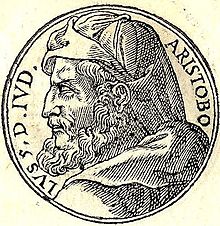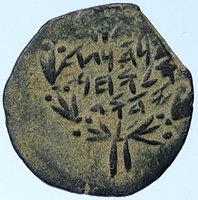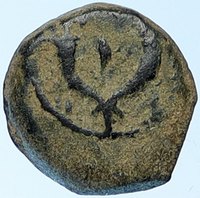Jewish Coin of
Judah Aristobulus I (Yehudah) King of Judaea: 104-103 B.C.E
Bronze 'Prutah' 13mm (2.44 grams) Jerusalem mint, struck circa 104 B.C.
Reference: Hendin 1143
Paleo-Hebrew inscription (Yehudah the High Priest and the Council of the Jews) in wedge-style characters within wreath.
Double cornucopia adorned with ribbons, pomegranate between horns, border of dots. The dies for this coin were either made by the same die cutter, or at least the same workshop of Jannaeus No. 1144, which suggests that this was the later of the Aristobulus types, and puts the coin immediately before the coins of Jannaeus. You are bidding on the exact item pictured, provided with a Certificate of Authenticity and Lifetime Guarantee of Authenticity.
Starting with the Jewish Kings, most coins were minted at the Jerusalem mint. The Hosmoneon Dynasty coinage begins with John Hyrcanus I (135-104 B.C.) followed by Judah Aristobulus (104 B.C.), then Alexander Jannaeus (104-76 B.C.). The Herodian Dynasty came next with Herod I (the Great) (40-4 B.C.), followed by Herod Archelaus (4 B.C. - 6 A.D.), Herod Antipas (4 B.C. - 39 A.D.), Herod Philip and Herod Agrippa I (41-44 A.D.).
Roman Procurator coinage was issued under procurators and prefects of the province of Judaea which minted coins with names of contemporary emperors between circa 6 - 66 A.D. They minted only one denomination and size, the bronze Prutah. Not all of the procurators and prefects issued coinage in the province of Judaea under the Romans. Those that did issue coins were Coponius (6-9 A.D.) (under the Roman emperor Augustus, 27 B.C.-14A.D.), Marcus Ambibulus (9-12 A.D.), Valerius Gratus (15-18/26 A.D.) (time of Roman emperor Tiberius 14-37 A.D.), Pontius Pilate (26-36 A.D.), Antonius Felix (52-60 A.D.) (under Roman emperor Claudius 41-54 A.D.), and Porcius Festus (59-62 A.D.) (under emperor Nero 54-68 A.D.). The last three procurators were Lucceius Albinus, Gessius Florus and Marcus Antonius Julianus. They did not issue any coins since the First Jewish-Roman War was brewing during emperor Nero's reign and the leaders of the revolt started issuing their own coins for the period known as the Jewish War (67-70 A.D.).
After the conquest of Jerusalem under Vespasian and Titus, this period of coinage ended and Romans commemorated the victories over Jerusalem and the surrounding area with Judaea Capta coinage.
 Judah Aristobulus I (Greek: Ἰούδας Ἀριστόβουλος Ioúdās Aristóboulos, the epithet meaning "best-advising"; reigned c. 104 - 103 BC) was the first ruler of the Hasmonean Dynasty to declare himself "king". He was the eldest of the five sons of John Hyrcanus, the previous leader. Judah Aristobulus I (Greek: Ἰούδας Ἀριστόβουλος Ioúdās Aristóboulos, the epithet meaning "best-advising"; reigned c. 104 - 103 BC) was the first ruler of the Hasmonean Dynasty to declare himself "king". He was the eldest of the five sons of John Hyrcanus, the previous leader.
Aristobulus was not only just the first king from the Hasmonean lineage, but the first of any Hebrew kings to claim both the high priesthood and the kingship title. The Sadducees and the Essenes were not concerned about Aristobulus taking the title of king, but the Pharisees were infuriated: they felt that the kingship could only be held by descendants of the Davidic line (the Hasmoneans were Levites). The Pharisees began a massive rebellion, but Aristobulus died before any attempt to depose of him could occur. Ascension as kingAccording to the directions of John Hyrcanus, the country after his death was to be placed in the hands of his wife, and Aristobulus was originally to receive the high-priesthood only. Aristobulus did not approve of his father's wishes, instead, he seized the crown with the support of his brother Antigonus. To secure his kingship, he had his mother placed in prison where she starved to death; and to ensure himself of any possible endangerment from his family, he placed his three brothers into prison except for Antigonus. Conquest of GalileeSee also: Judaization Much of the Galilee region was annexed by Aristobulus, however, there was some resistance from the Arab Ituraean tribes from the northern parts of the region. The terrain made campaigning difficult against the Galilee inhabitants. In the end, Aristobulus would eventually conquer much of the territory from them. The Golan region was also taken during the campaign and Mount Hermon as well. The conquered inhabitants were forced to accept the Jewish faith, primarily, circumcision was forcibly performed as the main step to conversion. Death and successorAristobulus's feeble health gradually lead his remaining reign under the control of a clique, at the head of which stood Queen Alexandra Salome, his wife. Through his machinations reign, he was led to suspect his favorite brother, Antigonus-whom he had entrusted with a share in the government, and whom he treated almost as a coregent-of designs against him. When he showed signs of disease, the queen conspired to murder Antigonus. She deceived the king with suggestions that Antigonus was attempting to overthrow him by force. Salome then convinced Antigonus that his king wished to see his new armor, while telling Aristobulus that his brother was coming to kill him. Antigonus was killed by Aristobulus's guards before he could get close to his brother. Days later, Aristobulus died from pain and internal bleeding from an unknown disease, which Jews perceived his death as a sign of God's disgruntlement. The queen released the younger brothers from prison, placing Alexander Jannaeus on the throne. Archeological findingsGalilee and Golan settlementsArchaeological findings in eastern Galilee and lower Golan reveal massive ethnic changes in the area just before, during, and immediately after Aristobulus's reign. Beginning with John Hyrcanus and ending with Alexander Jannaeus, large numbers of pro-Hasmonean Jews immigrated into those territories to support Hasmonean political, economic, and religious ideology, displacing much of the indigenous population. Although many of these towns were later seized by Roman forces who instituted pro-Hellenic policies, the previous Hasmonean influence survived and would incite conflict during and after the rule of Herod the Great. CoinageThe first mint of Hasmonean coins didn't begin until the leadership of John Hyrcanus. Like his father, Judah Aristobulus only minted his coins with the title of the high priesthood. It wasn't until Alexander Jannaeus that both the roles of kingship and the high priesthood were minted onto coins. The majority of Judah's coins were found in the regions of Galilee and the Golan, primary, the largest amount of coins were from Gamla. Majority of them come from his actual reign, while a small amount of these coins were minted after.
|


 Judah Aristobulus I (Greek: Ἰούδας Ἀριστόβουλος Ioúdās Aristóboulos, the epithet meaning "best-advising"; reigned c. 104 - 103 BC) was the first ruler of the Hasmonean Dynasty to declare himself "king". He was the eldest of the five sons of John Hyrcanus, the previous leader.
Judah Aristobulus I (Greek: Ἰούδας Ἀριστόβουλος Ioúdās Aristóboulos, the epithet meaning "best-advising"; reigned c. 104 - 103 BC) was the first ruler of the Hasmonean Dynasty to declare himself "king". He was the eldest of the five sons of John Hyrcanus, the previous leader.
